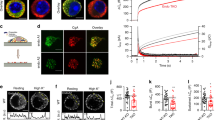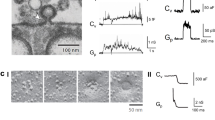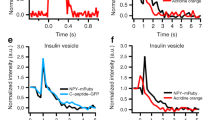Abstract
Regulated exocytosis is a process in which the membranes of cytoplasmic organelles fuse with the plasma membrane in response to stimulation. In many cases (secretory exocytoses), the process functions to secrete specific products that are segregated in the organelle lumen (for example, neurotransmitters, hormones and enzymes) to the extracellular space. In other cases ('non-secretory exocytoses'), it functions to transfer the organelle membrane and its components to the cell surface. Here, the general properties of non-secretory exocytoses are discussed.
This is a preview of subscription content, access via your institution
Access options
Subscribe to this journal
Receive 12 print issues and online access
$189.00 per year
only $15.75 per issue
Buy this article
- Purchase on Springer Link
- Instant access to full article PDF
Prices may be subject to local taxes which are calculated during checkout



Similar content being viewed by others
References
Palade, G. E. Functional changes in the structure of cell components. in Subcellular Particles. (ed. T. Hayashi) 64–83 (The Ronald Press Company, New York, 1959).
Jahn, R. & Sudhof, T. C. Membrane fusion and exocytosis. Annu. Rev. Biochem. 68, 863–911 (1999).
Burgoyne, R. D. & Morgan, A. Secretory granule exocytosis. Physiol. Rev. 83, 581–632 (2003).
Amsterdam, A., Ohad, I. & Schramm, M. Dynamic changes in the ultrastructure of the acinar cell of the rat parotid gland during the secretory cycle. J. Cell Biol. 41, 753–773 (1969).
Palade, G. E. Intracellular aspects of the process of protein secretion. Science 189, 347–358 (1975).
Slepnev, V. I. & De Camilli, P. Accessory factors in clathrin-dependent synaptic vesicle endocytosis. Nature Rev. Neurosci. 1, 161–172 (2000).
Maxfield, F. R. & McGraw, T. E. Endocytic recycling. Nature Rev. Mol. Cell Biol. 5, 121–132 (2004).
Lu, W. et al. Activation of synaptic NMDA receptors induces membrane insertion of new AMPA receptors and LTP in cultured hippocampal neurons. Neuron 29, 243–254 (2001).
Wan, Q. et al. Recruitment of functional GABA(A) receptors to postsynaptic domains by insulin. Nature 388, 686–690 (1997).
Chou, C. L. et al. Regulation of aquaporin-2 trafficking by vasopressin in the renal collecting duct. Roles of ryanodine-sensitive Ca2+ stores and calmodulin. J. Biol. Chem. 275, 36839–36846 (2000).
Kawanishi, M. et al. Role of SNAP23 in insulin-induced translocation of GLUT4 in 3T3-L1 adipocytes. Mediation of complex formation between syntaxin4 and VAMP2. J. Biol. Chem. 275, 8240–8247 (2000).
Bezzerides, V. J., Ramsey, I. S., Kotecha, S., Greka, A. & Clapham, D. E. Rapid vesicular translocation and insertion of TRP channels. Nature Cell Biol. 6, 709–720 (2004).
Malinow, R. & Malenka, R. C. AMPA receptor trafficking and synaptic plasticity. Annu. Rev. Neurosci. 25, 103–126 (2002).
Xiao, M. Y., Wasling, P., Hanse, E. & Gustafsson, B. Creation of AMPA-silent synapses in the neonatal hippocampu. Nature Neurosci. 7, 236–243 (2004).
Passafaro, M., Piech, V. & Sheng, M. Subunit-specific temporal and spatial patterns of AMPA receptor exocytosis in hippocampal neurons. Nature Neurosci. 4, 917–926 (2001).
Park, M., Penick, E. C., Edwards, J. G., Kauer, J. A. & Ehlers, M. D. Recycling endosomes supply AMPA receptors for LTP. Science 305, 1972–1975 (2004).
Hayashi, Y. et al. Driving AMPA receptors into synapses by LTP and CaMKII: requirement for GluR1 and PDZ domain interaction. Science 287, 2262–2267 (2000).
Lan, J. Y. et al. Protein kinase C modulates NMDA receptor trafficking and gating. Nature Neurosci. 4, 382–390 (2001).
Morenilla-Palao, C., Planells-Cases, R., Garcia-Sanz, N. & Ferrer-Montiel, A. Regulated exocytosis contributes to protein kinase C potentiation of vanilloid receptor activity. J. Biol. Chem. 279, 25665–25672 (2004).
Singh, B. B. et al. VAMP2-dependent exocytosis regulates plasma membrane insertion of TRPC3 channels and contributes to agonist-stimulated Ca2+ influx. Mol. Cell 15, 635–646 (2004).
Clapham, D. E. TRP channels as cellular sensors. Nature 426, 517–524 (2003).
Brown, D. The ins and outs of aquaporin-2 trafficking. Am. J. Physiol. Renal Physiol. 284, F893–F901 (2003).
Lorenz, D. et al. Cyclic AMP is sufficient for triggering the exocytic recruitment of aquaporin-2 in renal epithelial cells. EMBO Rep. 4, 88–93 (2003).
Gouraud, S. et al. Functional involvement of VAMP/synaptobrevin-2 in cAMP-stimulated aquaporin 2 translocation in renal collecting duct cells. J. Cell Sci. 115, 3667–3674 (2002).
Kamsteeg, E. J. et al. Reversed polarized delivery of an aquaporin-2 mutant causes dominant nephrogenic diabetes insipidus. J. Cell Biol. 163, 1099–1109 (2003).
Lin, D., Sterling, H., Lerea, K. M., Giebisch, G. & Wang, W. H. Protein kinase C (PKC)-induced phosphorylation of ROMK1 is essential for the surface expression of ROMK1 channels. J. Biol. Chem. 277, 44278–44284 (2002).
Feranchak, A. P., Kilic, G., Wojtaszek, P. A., Qadri, I. & Fitz, J. G. Volume-sensitive tyrosine kinases regulate liver cell volume through effects on vesicular trafficking and membrane Na+ permeability. J. Biol. Chem. 278, 44632–44638 (2003).
Watson, R. T., Kanzaki, M. & Pessin, J. E. Regulated membrane trafficking of the insulin-responsive glucose transporter 4 in adipocytes. Endocr. Rev. 25, 177–204 (2004).
Tengholm, A. & Meyer, T. A PI3-kinase signaling code for insulin-triggered insertion of glucose transporters into the plasma membrane. Curr. Biol. 12, 1871–1876 (2002).
Xu, Z. & Kandror, K. V. Translocation of small preformed vesicles is responsible for the insulin activation of glucose transport in adipose cells. Evidence from the in vitro reconstitution assay. J. Biol. Chem. 277, 47972–47975 (2002).
Hyde, R., Peyrollier, K. & Hundal, H. S. Insulin promotes the cell surface recruitment of the SAT2/ATA2 system A amino acid transporter from an endosomal compartment in skeletal muscle cells. J. Biol. Chem. 277, 13628–13634 (2002).
du Cheyron, D. et al. Angiotensin II stimulates NHE3 activity by exocytic insertion of the transporter: role of PI 3-kinase. Kidney Int. 64, 939–949 (2003).
Okamoto, C. T. & Forte, J. G. Vesicular trafficking machinery, the actin cytoskeleton, and H+-K+-ATPase recycling in the gastric parietal cell. J. Physiol. 532, 287–296 (2001).
Li, G., Alexander, E. A. & Schwartz, J. H. Syntaxin isoform specificity in the regulation of renal H+-ATPase exocytosis. J. Biol. Chem. 278, 19791–19797 (2003).
Perez, J. F., Ruiz, M. C. & Michelangeli, F. Simultaneous measurement and imaging of intracellular Ca2+ and H+ transport in isolated rabbit gastric glands. J. Physiol. 537, 735–745 (2001).
Oliveira-Souza, M., Musa-Aziz, R., Malnic, G. & De Mello Aires, M. Arginine vasopressin stimulates H+-ATPase in MDCK cells via V1 (cell Ca2+) and V2 (cAMP) receptors. Am. J. Physiol. Renal Physiol. 286, F402–F408 (2004).
Karvar, S., Yao, X., Crothers, J. M. Jr, Liu, Y. & Forte, J. G. Localization and function of soluble N-ethylmaleimide-sensitive factor attachment protein-25 and vesicle-associated membrane protein-2 in functioning gastric parietal cells. J. Biol. Chem. 277, 50030–50035 (2002).
Ammar, D. A., Zhou, R., Forte, J. G. & Yao, X. Syntaxin 3 is required for cAMP-induced acid secretion: streptolysin O-permeabilized gastric gland model. Am. J. Physiol. Gastrointest. Liver Physiol. 282, G23–G33 (2002).
Morris, C. E. & Homann, U. Cell surface area regulation and membrane tension. J. Membr. Biol. 179, 79–102 (2001).
Loncar, D. & Singer, S. J. Cell membrane formation during the cellularization of the syncytial blastoderm of Drosophila. Proc. Natl Acad. Sci. USA 92, 2199–2203 (1995).
Lecuit, T. & Wieschaus, E. Polarized insertion of new membrane from a cytoplasmic reservoir during cleavage of the Drosophila embryo. J. Cell Biol. 150, 849–860 (2000).
Pelissier, A., Chauvin, J. P. & Lecuit, T. Trafficking through Rab11 endosomes is required for cellularization during Drosophila embryogenesis. Curr. Biol. 13, 1848–1857 (2003).
Finger, F. P. & White, J. G. Fusion and fission: membrane trafficking in animal cytokinesis. Cell 108, 727–730 (2002).
Danilchik, M. V., Bedrick, S. D., Brown, E. E. & Ray, K. Furrow microtubules and localized exocytosis in cleaving Xenopus laevis embryos. J. Cell Sci. 116, 273–283 (2003).
Low, S. H. et al. Syntaxin 2 and endobrevin are required for the terminal step of cytokinesis in mammalian cells. Dev. Cell 4, 753–759 (2003).
Martinez-Arca, S. et al. A common exocytotic mechanism mediates axonal and dendritic outgrowth. J. Neurosci. 21, 3830–3838 (2001).
Pfenninger, K. H. et al. Regulation of membrane expansion at the nerve growth cone. J. Cell Sci. 116, 1209–1217 (2003).
Wayman, G. A. et al. Regulation of axonal extension and growth cone motility by calmodulin-dependent protein kinase I. J. Neurosci. 24, 3786–3794 (2004).
Martinez-Arca, S., Alberts, P., Zahraoui, A., Louvard, D. & Galli, T. Role of tetanus neurotoxin insensitive vesicle-associated membrane protein (TI-VAMP) in vesicular transport mediating neurite outgrowth. J. Cell Biol. 149, 889–900 (2000).
Holevinsky, K. O. & Nelson, D. J. Membrane capacitance changes associated with particle uptake during phagocytosis in macrophages. Biophys. J. 75, 2577–2586 (1998).
Di, A. et al. Dynamin regulates focal exocytosis in phagocytosing macrophages. Mol. Biol. Cell 14, 2016–2028 (2003).
Bajno, L. et al. Focal exocytosis of VAMP3-containing vesicles at sites of phagosome formation. J. Cell Biol. 149, 697–706 (2000).
Borgonovo, B. et al. Regulated exocytosis: a novel, widely expressed system. Nature Cell Biol. 4, 955–962 (2002).
Cerny, J. et al. The small chemical vacuolin-1 inhibits Ca2+-dependent lysosomal exocytosis but not cell resealin. EMBO Rep. 5, 883–888 (2004).
Cocucci, E., Racchetti, G., Podini, P., Rupnik, M. & Meldolesi, J. Enlargeosome, an exocytic vesicle resistant to non-ionic detergents, undergoes endocytosis via a non-acidic route. Mol. Biol. Cell 15, 5356–5368 (2004).
Bansal, D. et al. Defective membrane repair in dysferlin-deficient muscular dystrophy. Nature 423, 168–172 (2003).
Ju, W. et al. Activity-dependent regulation of dendritic synthesis and trafficking of AMPA receptors. Nature Neurosci. 7, 244–253 (2004).
Nichols, B. J. & Lippincott-Schwartz, J. Endocytosis without clathrin coats. Trends Cell Biol. 11, 406–412 (2001).
Parton, R. G. & Richards, A. A. Lipid rafts and caveolae as portals for endocytosis: new insights and common mechanisms. Traffic 4, 724–738 (2003).
Pelkmans, L., Burli, T., Zerial, M. & Helenius, A. Caveolin-stabilized membrane domains as multifunctional transport and sorting devices in endocytic membrane traffic. Cell 118, 767–780 (2004).
Zeigerer, A. et al. GLUT4 retention in adipocytes requires two intracellular insulin-regulated transport steps. Mol. Biol. Cell 13, 2421–2435 (2002).
Watson, R. T. et al. Entry of newly synthesized GLUT4 into the insulin-responsive storage compartment is GGA dependent. EMBO J. 23, 2059–2070 (2004).
Bredt, D. S. & Nicoll, R. A. AMPA receptor trafficking at excitatory synapses. Neuron 40, 361–379 (2003).
Shigematsu, S., Watson, R. T., Khan, A. H. & Pessin, J. E. The adipocyte plasma membrane caveolin functional/structural organization is necessary for the efficient endocytosis of GLUT4. J. Biol. Chem. 278, 10683–10690 (2003).
Pastor-Soler, N. et al. Bicarbonate-regulated adenylyl cyclase (sAC) is a sensor that regulates pH-dependent V-ATPase recycling. J. Biol. Chem. 278, 49523–49529 (2003).
Blott, E. J. & Griffiths, G. M. Secretory lysosomes. Nature Rev. Mol. Cell Biol. 3, 122–131 (2002).
Jaiswal, J. K., Andrews, N. W. & Simon, S. M. Membrane proximal lysosomes are the major vesicles responsible for calcium-dependent exocytosis in nonsecretory cells. J. Cell Biol. 159, 625–635 (2002).
Acknowledgements
The original studies by E.C. and J.M. that are reported in this article were supported by grants from the European Union (Growbeta), Italian Ministry of Research (Co-Fin and FIRB), and Telethon.
Author information
Authors and Affiliations
Corresponding author
Ethics declarations
Competing interests
The authors declare no competing financial interests.
Related links
Related links
DATABASES
Swiss-Prot
Rights and permissions
About this article
Cite this article
Chieregatti, E., Meldolesi, J. Regulated exocytosis: new organelles for non-secretory purposes. Nat Rev Mol Cell Biol 6, 181–187 (2005). https://doi.org/10.1038/nrm1572
Issue Date:
DOI: https://doi.org/10.1038/nrm1572
This article is cited by
-
Mechanisms of Inhibition of Excessive Microglial Activation by Melatonin
Journal of Molecular Neuroscience (2020)
-
Effects of near infrared focused laser on the fluorescence of labelled cell membrane
Scientific Reports (2018)
-
Uncoupling Protein 2 Inhibition Exacerbates Glucose Fluctuation-Mediated Neuronal Effects
Neurotoxicity Research (2018)
-
Functional effects of proinflammatory factors present in Sjögren’s syndrome salivary microenvironment in an in vitro model of human salivary gland
Scientific Reports (2017)
-
Pemafibrate, a novel selective peroxisome proliferator-activated receptor alpha modulator, improves the pathogenesis in a rodent model of nonalcoholic steatohepatitis
Scientific Reports (2017)



